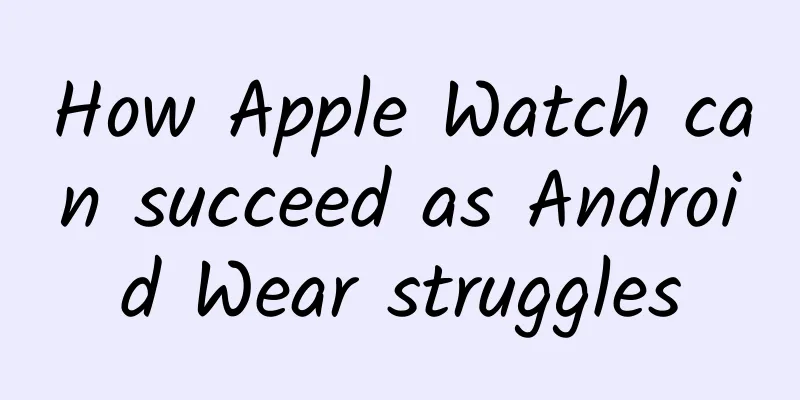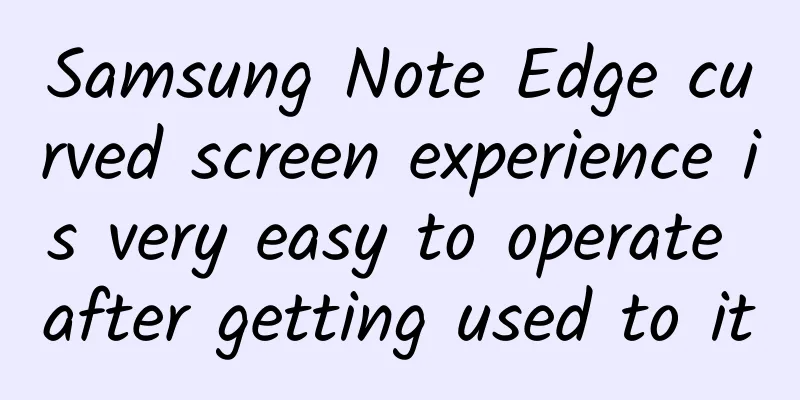How Apple Watch can succeed as Android Wear struggles

|
Given the current slow development trend of the smartwatch market, can Apple Watch meet consumer expectations and break the ice to create new business horizons? Apple Watch will be officially launched in the market in April this year, but judging from the current situation, the smart watch market has still not been able to bring any truly attractive highlights to consumers. Canalys recently released a report stating that device manufacturers shipped only 720,000 units of Android Wear products based on Google's smartwatch operating system in 2014. To put this in context, global shipments of smartwatches and wristbands totaled 4.6 million units last year, while Pebble, a rising star in the mobile market, shipped more than 1 million devices between its founding in 2013 and 2014, Canalys said in the report. Meanwhile, JPMorgan Chase wireless analyst Rod Hall recently released his own research findings, saying that according to a Barron's blog post, Apple's stock price rose from $140 per share to $145 per share due to market expectations for the Apple Watch. This excitement comes from the strong market expectations that 5% of the estimated 525 million iPhone users will choose to buy Apple Watch this year, which will bring Apple Watch shipments to more than 26 million units. Hall even boldly predicted that by 2016, 13% of iPhone customers will buy Apple Watch products, which will mean that its total shipments will exceed 55 million units. Therefore, at least one professional analyst believes that the market size of Apple Watch will be four times the current market size within the first year of the product's launch, and will double this size within the second year. There's still a long way to go to achieve this goal, especially considering that Google, the mobile giant with more than 1 billion active Android users, only shipped 720,000 Android Wear devices in 2014. Given this, how can Apple deliver results that match analysts’ expectations? Well, Chris Jones, vice president and senior analyst at Canalys, pointed out that Samsung is still the leader in the smartphone and watch market, but has not been able to "win customers over to its side." Faced with this situation, it seems that Apple will have no trouble promoting the Apple Watch. However, Jones also pointed out that Samsung "must focus on its Tizen OS for wearable devices while trying to keep developers interested." In fact, the weak app lineup is one of the main reasons why it is struggling in the smartwatch market - Samsung is currently in the transition phase from Android to its own Tizen OS, which will inevitably slow down the company's actions in other areas. In any case, this situation will not occur at all with Apple, so there is certainly no need to worry about it. As for attracting developers, Apple released its WatchKit SDK to developers in November last year. Especially considering the recent impressive sales of iPhone, it is probably difficult for developers to ignore Apple Watch, a new product type also from Apple. One of the constant themes when discussing the smartwatch market is the performance of the hardware. If the battery is always low, people will not bring such a device into their lives. The same is true at the functional level - if users need to press a button to wake up the screen and see the time, the experience of using a smartwatch is not much better than that of a smartphone. This kind of problem has not been effectively solved in the design of smartwatches - a screen that is always on will burn through the battery. Although Canalys analyst Daniel Matte said the Apple Watch will offer "leading energy efficiency" and noted that Android Wear "will need to make significant improvements in this area in the future," a recent report published by 9 to 5 Mac cited Apple sources as saying that the Apple Watch's battery life is only three and a half hours with standard app usage and the screen active. In other words, the Apple Watch and Android Wear devices are about evenly matched in terms of battery life. Battery life is a legitimate concern, and a lack of it would have a significant negative impact on the Apple Watch. According to comments in the 9 to 5 Mac report, Apple is well aware of the importance of battery life and has invested a staggering amount of money in research and development to address this problem. We can assume that Apple will eventually extend the battery life of its Apple Watch, but battery life will be a significant barrier to market adoption for at least the next *** years. But all of the above is not the core focus. The most important problem Apple needs to solve is to meet people's high expectations for Apple Watch and let every buyer get this exquisite product in time. Judging from the current production capacity, such a goal may be difficult to achieve. Looking at the history of Apple's development, many of its technical solutions and new product types have aroused widespread interest, especially the iPad. However, the iPad achieved many functions that other products could not achieve at that time - it combined mobility with mobile applications that have gradually grown since the birth of the iPhone, while providing it with ample display area similar to the size of a laptop. However, with the gradual increase in the size of smartphone screens, especially the appearance of the new generation of iPhones, the sales of the iPad have been seriously affected. People do not need two devices that can complete the same type of work. This is the main dilemma Apple faces in promoting the Apple Watch. I have written before about how Apple can succeed in the market with applications that are extremely important to consumers, such as health, media, and communications, but cheaper smart wristbands can also capture this information and send it back to smartphones. People are always cautious about such products, except for a niche group of sports enthusiasts. And anyone who has followed the sales of Google Glass must know that consumers always have a lingering hesitation when it comes to wearable devices. It’s clear that the entire technology industry has seen smartwatches as a viable product category. In fact, manufacturers have no choice but to go down this path because there is not enough room for development in other paths. |
<<: Server performance issues that PHPers should pay attention to – Tingyun Server trial notes
>>: Tencent CEO Ma Huateng: 100 million out of 500 million red envelopes were used to pay taxes
Recommend
Don’t talk about big data! Focus on the user first
Big data is very popular. Dan Ariely, founder of ...
11 suggestions on how to carry out ground promotion in a refined manner
Since I started my business and entered the field...
Speed: 22,530 km/h The spacecraft deliberately hit an asteroid Humanity's first asteroid defense test successfully implemented a "kinetic collision"
In science fiction movies, there is often an &quo...
China's first Olympic gold medal 40 years ago! The ten rings in the shooting competition turned out to be so small? !
Review expert: Peng Guoqiu, deputy chief physicia...
Can you drink overnight or boiled water? Many people don’t expect the consequences!
Information source: "Tencent Medical Diction...
Bong bracelet price cut reflects the "alchemy" of wearable devices
Since the price of Xiaomi Mi Band was announced a...
Four satellites in one rocket! Kuaizhou-1 has a good start! Tianmu-1 constellation phase networking is complete!
At 19:20 on January 5, 2024, the Kuaizhou-1A soli...
When increasing user growth, how can we retain new users?
Retention of new users is a very important part o...
I give five thumbs up and four thumbs down to the TV Game Lobby
For ordinary users, the TV gaming experience does ...
How to find camping sites in 2022? Here are some recommendations for camping spots in Chengdu!
Camping and barbecue are the favorite things for m...
Frozen hands and feet may cause stroke! Remember the key points of prevention!
Under the influence of strong cold air After the ...
Every autumn, it’s not just the plants that are “harvesting”…
Produced by: Science Popularization China Author:...
3 questions you must know about APP promotion and operation
3 questions you must know about APP promotion and...
In a chicken farm deep in the mountains, a "rocket" was successfully launched!
“I think I’ll see the Milky Way when I go into sp...
Pet cloning: The cost of "resurrecting" a pet is the killing of countless animals
The principle of pet cloning seems simple. Take a...









